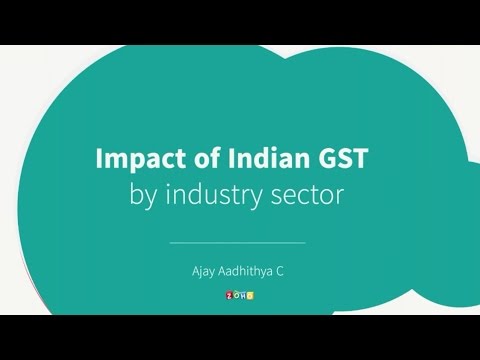Key Takeaways
- Revolutionary Tax Reform: GST has unified India’s complex tax system into a single tax regime, significantly enhancing the ease of doing business and economic efficiency.
- Simplified Tax Structure: By replacing multiple indirect taxes with a single tax, GST has streamlined business operations, fostering growth and development.
- Enhanced Compliance and Efficiency: The introduction of GST has made tax compliance easier for traders and improved the overall efficiency of the tax system.
- Broader Tax Base: GST has expanded the tax base by including various goods and services under its ambit, leading to increased revenue for the government.
- Impact on Prices: The effect of GST on prices has been mixed, with some goods becoming cheaper due to reduced tax rates, while others have seen price increases due to higher GST slabs.
The Goods and Services Tax (GST) is an innovative reform that has changed the structure of the indirect tax system in India and opened up trade and commerce in general across most of the business sectors. The inclusive tax deprived the composite systems of taxes and changed them into the sole tax regime to smooth the running of business, growth, and development.
What is Traders?

Traders are individuals or entities that engage in the buying and selling of goods, services, financial instruments, or any other form of exchangeable item with the aim of making profits from their transactions.
They operate in various markets, including retail, wholesale, financial markets (such as stock markets, forex, and commodities), and online platforms. Traders can be categorized into different types based on their trading activities, such as:
- Retail traders: These are individuals who trade on their own behalf, often through brokerage accounts, buying and selling stocks, bonds, commodities, or other securities in financial markets.
- Wholesale Traders: These traders deal with the buying and selling of goods in large quantities, typically to retailers, other wholesalers, or professional business users, rather than to end consumers.
- Day Traders: These individuals buy and sell financial instruments within the same trading day, aiming to capitalize on short-term market fluctuations. They rarely hold positions overnight.
- Commodity Traders: They specialize in trading commodities, such as oil, gold, and agricultural products, either through spot markets or derivatives like futures and options.
- Forex Traders: Forex (foreign exchange) traders focus on trading currencies, attempting to benefit from changes in exchange rates between different currencies.
- Algorithmic Traders: These traders use computer programs and algorithms to make high-speed trading decisions based on market data and predefined criteria.
Is GST applicable for traders?
Yes, GST is applicable to traders in India, affecting their operations, compliance, and financial flow. The Goods and Services Tax (GST) is applicable to traders. GST, a comprehensive, multi-stage, destination-based tax introduced in India, is levied on every value addition throughout the supply chain.
Traders, like other businesses involved in the buying and selling of goods and services, are required to register for GST if their annual turnover exceeds a certain threshold, which is currently set at ₹20 lakhs for most states and ₹10 lakhs for North-Eastern and hill states. Once registered, traders need to charge GST on the goods and services they sell and can claim input tax credit (ITC) for the tax paid on their purchases.
This mechanism is designed to make GST a tax only on the value added at each stage, with the final burden of the tax falling on the end consumer. This system ensures that traders and other businesses only act as intermediaries in the collection and remittance of the tax, thereby streamlining and simplifying the tax structure across the country.
Scope of applicability
The scope of applicability of the Goods and Services Tax (GST) is quite broad, covering almost all forms of goods and services in the country. GST is designed to be a comprehensive, nationwide tax system that replaces many existing indirect taxes such as excise duty, VAT, service tax, etc.
Here are the key aspects of it’s applicability:
- y:ationwide Implementation: GST is implemented across all states and union territories in India, ensuring a uniform tax structure throughout the country.
- Goods and Services: GST applies to the supply of both goods and services, making it a comprehensive tax system. This includes physical products, digital goods, and all forms of services.
- Supply Chain: Every stage of the supply chain, from manufacture to final consumption, falls under the ambit of GST, ensuring that tax is levied at each value addition point.
- Import of Goods and Services: GST is also applicable to the import of goods and services into India, where it is considered as an inter-state supply and attracts Integrated GST (IGST).
- Threshold Limit: Small businesses with an annual turnover below a specified threshold limit (₹20 lakhs for most states, ₹10 lakhs for North-Eastern and hill states) are exempt from registering for GST. However, they have the option to register voluntarily.
- Reverse Charge: In certain cases, the liability to pay tax is on the recipient of goods/services instead of the supplier, under the reverse charge mechanism (RCM).
- E-commerce Operators: Specific provisions are applicable to e-commerce operators and suppliers selling goods or services through these platforms, ensuring that transactions conducted online are also within the GST framework.
- Composition Scheme: For small taxpayers to reduce compliance costs, the GST offers a Composition Scheme allowing eligible businesses to pay tax at a nominal rate based on their turnover.
GST registration for traders

For the purpose of facilitating their entry into the GST system, traders must register under GST if their annual turnover exceeds the GST council’s set threshold limit.
It involves obtaining a unique GST Identification Number (GSTIN) from the government, which is used for all GST-related activities, including filing returns, paying taxes, and claiming input tax credits.
Here’s an overview of the GST registration process and requirements for traders
Eligibility for GST Registration
- Mandatory Registration: Traders whose turnover exceeds the threshold limit of ₹20 lakhs (for services) and ₹40 lakhs (for goods) in a financial year are required to register for GST. For special category states (North-Eastern states, Himachal Pradesh, Uttarakhand, and Jammu & Kashmir), the threshold is ₹10 lakhs.
- Voluntary Registration: Traders with turnover below the threshold limit can also opt for voluntary registration. This allows them to claim input tax credit and be a part of the GST chain.
- Inter-State Traders: Traders who supply goods and/or services in more than one state or union territory are required to register for GST, regardless of their turnover.
- E-commerce Operators and Suppliers: Those who supply goods or services through e-commerce platforms need to register for GST, irrespective of their turnover.
- Casual Taxable Persons: Traders who occasionally supply goods or services in a territory where GST is applicable but do not have a fixed place of business must register as casual taxable persons.
Steps for GST Registration
Step 1: Visit the GST Portal. Start by visiting the official GST portal (www.gst.gov.in).
Step 2: Fill in the application. Complete the registration application form (Form GST REG-01) online. This involves providing details such as PAN, business details, bank account details, and contact information.
Step 3: Upload Required Documents: Submit the necessary documents, which typically include proof of business registration, photographs of the proprietor/partners, proof of business address, bank account statements, and the authorization form for the signatory.
Step 4: Verification and Approval: Once the application and documents are submitted, they undergo verification by the tax authorities. If everything is in order, the GSTIN is issued.
Step 5: ARN Number: After submitting the application, an Application Reference Number (ARN) is generated, which can be used to track the status of the application.
Documents Required for GST Registration
- PAN card of the business or proprietor
- Proof of business registration or incorporation certificate
- Identity and address proof of promoters/directors with photographs
- Address proof of the business location
- Bank account statement/cancelled check
- Authorization letter/power of attorney for the authorized signatory
Input Tax Credit for traders:
Input Tax Credit (ITC) is a mechanism in the Goods and Services Tax (GST) framework that allows traders and other businesses to reduce their tax liability by claiming credit for the tax already paid on the purchase of goods and services used in the supply of their own goods or services.
This feature is designed to avoid the cascading tax effect, where tax is paid on tax, and ensure that the final tax burden is passed on to the end consumer.
Key Features of Input Tax Credit for Traders
Eligibility for ITC: To be eligible to claim ITC, traders must be registered under GST. The goods and services on which the credit is claimed must be used for business purposes, and there should be a tax invoice or debit note issued by a registered supplier.
Conditions for Claiming ITC: Traders can claim ITC only if
- They have a tax invoice or debit note issued by a registered supplier.
- They have received the goods and/or services.
- The tax charged on their purchases has been actually paid to the government by the supplier.
- They have filed their GST returns.
- Utilization of ITC: The ITC can be used to pay the GST due on the supply of goods and services. However, it’s important to note that the ITC on the Central GST (CGST) can only be used to pay CGST or Integrated GST (IGST), while the ITC on State GST (SGST) can only be used to pay SGST or IGST. ITC on IGST can be used to pay IGST, CGST, and SGST in that order of priority.
- Documentation and Compliance: Traders must maintain proper documentation, such as invoices and receipts, to support their ITC claims. They must also ensure compliance with the filing of regular GST returns to claim ITC.
- Reversal of ITC: In certain situations, such as non-payment of invoices within 180 days, use of goods or services for personal use, or goods lost, stolen, or destroyed, the ITC claimed must be reversed and added back to the output tax liability.
- Special Provisions for Banking Sector and Others: There are special provisions for banking and financial institutions, including a choice between availing 100% ITC on inputs or opting for a 50% blanket ITC to simplify their credit claims.
Benefits of Input Tax Credit for Traders
- Reduction in Cost: ITC helps in lowering the cost of inputs, which can reduce the overall cost of goods or services provided by the trader, potentially leading to competitive pricing.
- Avoidance of Double Taxation: By allowing traders to claim credit for the GST paid on their inputs, the GST framework prevents double taxation, ensuring that tax is only paid on the value addition.
- Improved Cash Flow: ITC mechanism helps in improving the cash flow for traders by reducing the cash outlay required for tax payments on inputs.
- Enhanced Compliance: The need to avail ITC encourages traders to buy from registered suppliers and maintain proper documentation, thereby improving compliance levels across the supply chain.
How GST Works in Trading
The Goods and Services Tax (GST) has reformed the tax structure for traders in India by streamlining the indirect tax system.

GST in trading works by implementing a unified tax on the supply of goods and services, from the manufacturer to the end consumer, making it a comprehensive, multi-stage, destination-based system.
Here’s a breakdown of how GST operates in the trading sector
Registration
- Mandatory Registration: Traders whose turnover exceeds the threshold limit (₹20 lakhs for services and ₹40 lakhs for goods in most states, with variations for special category states) must register for GST.
- Voluntary Registration: Traders below the threshold can also opt for GST registration to avail benefits like input tax credit.
Collection of GST on Sales
Traders charge GST on the sale of goods and services to their customers. The rate of GST depends on the product category, with essential items attracting lower rates and luxury items attracting higher rates. GST is divided into CGST (Central GST) and SGST (State GST) for intra-state sales, while IGST (Integrated GST) is charged for inter-state sales.
Claiming Input Tax Credit (ITC)
Traders can claim ITC for the GST paid on their purchases, including goods and services used for business purposes. This mechanism ensures that tax is paid only on the value addition at each stage.
To claim ITC, traders must have valid tax invoices and ensure that their suppliers have paid the corresponding tax to the government.
Remittance of Net GST
After adjusting the ITC, traders remit the net GST to the government. This means they only pay tax on the value addition rather than the entire sale or purchase value.
The process involves deducting the ITC from the GST collected on sales and remitting the balance to the government.
Compliance Requirements
- Filing Returns: Traders are required to file monthly, quarterly, or annual GST returns based on their turnover and the scheme they are registered under.
- Invoices: Maintaining detailed tax invoices for all transactions is crucial. These invoices must include GST rates and amounts for both sales and purchases.
- Record Keeping: Traders must keep records of all transactions, tax payments, and ITC for at least six years.
- Audit: Depending on their turnover, traders may be subject to GST audits by tax authorities to ensure compliance.
Impact of GST on Trade and Commerce
- Simplified Tax Structure: GST has replaced multiple indirect taxes, simplifying the tax regime and making it easier for traders to comply.
- Improved Cash Flow: By allowing the claim of ITC, GST has improved the cash flow for traders, as it reduces the upfront tax cost on purchases.
- Enhanced Transparency: GST has increased transparency in the trading sector by mandating detailed invoices and regular filing of returns.
- Inter-State Trading: With the introduction of IGST, GST has facilitated smoother inter-state trading by eliminating the need for multiple state taxes.
Impact of GST on Traders and GST Applicability [Supply]
The Goods and Services Tax (GST) in India has significantly impacted traders, manufacturers, distributors, and retailers by streamlining the tax structure and altering the way business is conducted. This article will outline the effect of GST on both the supplier and recipient by dwelling on the location of the supply, the recurrent period of the supply, the gross value of the supply, invoicing, and return filing.
The GST, which was introduced on all goods and services, has replaced many state taxes to make the tax system simple and the same from one state to another. This has simplified the task of paying multiple taxes and now it’s easy for business to do their duties. At the same time, knowledge of the new rules and regulations is necessary.
Place of Supply of Goods under GST
The place of supply determines which state will receive the tax revenue. It’s crucial for determining whether a transaction is intrastate (subject to CGST and SGST/UTGST) or interstate (subject to IGST). For traders, knowing the place of supply helps in charging the correct tax on invoices.
Time of Supply in GST
The time of supply dictates when the tax liability arises, determining the tax rate and the due dates for tax payments. For goods, it’s generally the earliest of the date of removal of goods or the date on which the invoice is issued. For services, it’s the date of invoice issuance or payment receipt. This helps traders manage their cash flows and tax liabilities efficiently.
Value of Supply under GST: Applicable to the Traders
The value of supply includes the transaction value of goods and services, excluding GST. Traders must include any additional charges or discounts in the transaction value to accurately calculate the GST payable. This impacts pricing strategies and the bottom line for traders.
Impact of GST on Traders: Invoicing under GST
GST has standardized invoicing practices, requiring detailed invoices that include GST rates and amounts, place of supply, and HSN codes for goods or SAC codes for services. This has increased transparency but also necessitated updates to accounting and billing software for compliance.
Return Filing under GST for Traders
Traders are required to file regular GST returns, detailing their sales, purchases, tax collected on sales (output tax), and tax paid on purchases (input tax credit). This has increased compliance requirements but also allows for the automatic reconciliation of input tax credits, improving efficiency.
Impact of GST on Manufacturers, Distributors, & Retailers
- Manufacturers: GST has eliminated the cascading effect of taxes, reducing production costs. However, it also requires compliance with new regulations and an understanding of input tax credits.
- Distributors: The streamlined tax structure under GST has facilitated smoother movement of goods across states, reducing the logistics costs and complexities associated with state-specific taxes.
- Retailers: Retailers benefit from the input tax credit for taxes paid on purchases, which can be set off against taxes on sales. The simplified tax regime has also made it easier to conduct business across states.
Sector-Wise GST Impact Analysis
The Goods and Services Tax (GST) has had a far-reaching impact across various sectors of the Indian economy, simplifying the tax structure, enhancing compliance, and aiming to make the business environment more efficient. Here’s a sector-wise analysis of GST’s impact:

Sector Positive Impact Challenges
| Sector | Positive Impact | Challenges |
|---|---|---|
| Automobiles | Reduced overall tax burden on many categories, potentially lowering prices and boosting demand. | Higher GST rates on luxury vehicles and SUVs could impact demand. |
| FMCG | Elimination of cascading tax effects leads to lower production costs and potentially lower consumer prices. | Small-scale manufacturers may struggle with increased compliance costs and technological upgrades. |
| Freelancers | Clarity in taxation and the ability to claim input tax credits reduce tax liability. | low threshold for GST registration increases the administrative burden. |
| E-commerce | Level playing field due to uniform tax rates; TCS ensures compliance across the supply chain. | Increased compliance and operational costs due to TCS provisions. |
| Logistics | Faster movement of goods and a reduction in logistics costs are due to the elimination of state checkpoints. | Adaptation to new tax regime and updating IT systems for compliance. |
| Pharmaceuticals | A rationalized tax structure is expected to make healthcare more affordable. | Initial disruptions and adjustment period required for stakeholders. |
| Real Estate | Transparency with a uniform tax rate could potentially reduce the cost of home ownership. | Challenges with the input tax credit mechanism affect cost structures. |
| Startups | Easier operations across states without multiple VAT registrations; reduced tax burden due to input tax credit. | Compliance and administrative burden, especially for those with limited resources. |
| Telecommunications | A simplified tax regime could potentially lead to operational efficiencies. | Increased tax rates under GST could affect consumer costs and demand. |
| Textile | Potential unification under a single tax regime, improving compliance and reducing tax evasion. | Transition challenges include compliance costs and understanding the new tax structure, especially in the unorganized segment. |
Conclusion
GST has significantly impacted trade and commerce in India, bringing both challenges and opportunities for traders and other stakeholders. As the system matures, it promises to streamline business operations and foster a more inclusive economic environment.
For seamless GST compliance and optimization of tax benefits, it’s crucial for traders and businesses to stay informed and adapt to the evolving tax landscape.
💡For more information on how our app helps to make efficient GST payments and other business payments, download the Pice App, book a demo session, and see how we can help.
FAQs
Is GST registration mandatory for all traders?
GST registration is mandatory for traders whose turnover exceeds the threshold limit of INR 20 lakhs (INR 10 lakhs for North-Eastern states, Jammu & Kashmir, Himachal Pradesh, and Uttarakhand) for services and INR 40 lakhs for goods. However, traders involved in the supply of certain goods or services that are interstate, make taxable supplies on behalf of a taxable person, or are required to pay tax under reverse charge must register for GST regardless of their turnover. This ensures compliance with tax laws and enables them to claim input tax credits.
How does GST affect the pricing of goods for traders?
GST affects the pricing of goods for traders by streamlining the tax structure, eliminating the cascading effect of previous indirect taxes like VAT, excise, and service tax. This can lead to reduced costs for goods due to input tax credit availability across the supply chain, potentially lowering prices for consumers. However, the actual impact on pricing also depends on the GST rate applicable to specific goods and the efficiency of the trader in utilizing the input tax credit, which could lead to variations in final consumer prices.
Can traders claim ITC for all their purchases?
Traders can claim input tax credit (ITC) for GST paid on their purchases that are used for business purposes and make taxable supplies, including zero-rated supplies. However, ITC cannot be claimed for goods or services that are exempt from GST, used for personal consumption, or fall under the GST law’s blocked credits category, such as employee-related expenses not mandated by law. Ensuring proper documentation and compliance with GST regulations is crucial for claiming ITC effectively.
What are the major compliance requirements under GST for traders?
Major compliance requirements under GST for traders include obtaining GST registration if turnover exceeds the specified threshold, filing periodic GST returns (monthly, quarterly, and annually), and making timely GST payments. Traders must also maintain accurate records of all taxable goods and services, input tax credits, and issued tax invoices. Compliance with these requirements ensures transparency in transactions, facilitates the claiming of input tax credits, and helps avoid penalties for non-compliance.
How has GST impacted the competitiveness of Indian traders in the global market?
GST has enhanced the competitiveness of Indian traders in the global market by streamlining the tax structure, reducing the cascading effect of taxes, and making Indian goods and services more cost-effective. The introduction of zero-rated exports under GST allows traders to refund input taxes, reducing their overall costs. This, combined with simplified compliance and logistics under the unified GST system, has improved the ease of doing business, making Indian traders more competitive on a global scale.








